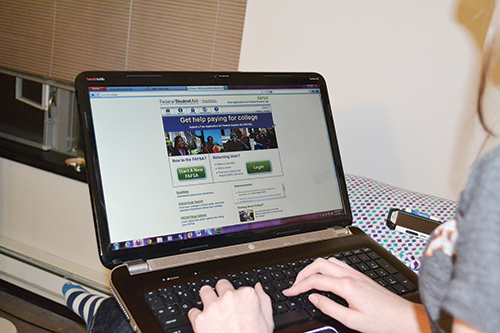
If you want to get all the grant money you’re eligible for in the state of Oregon, don’t wait—fill out your Free Application for Federal Student Aid today.
That’s because two key pots of money for Oregon students—the Oregon Opportunity Grant and work-study funds—empty quickly, and only the earliest applicants are awarded the funds.
“There is an ever-increasing number of students who want work-study and grant funds,” said Deanna Smith, assistant director of financial aid at Portland State.
The Oregon Opportunity Grant
The OOG is a state-funded grant provided to students by taxpayers. It is awarded to students with financial need. Students can receive the grant for a maximum of four years. The grant is not awarded during the summer, and all students who receive funding must be attending school at least half time. For the 2013–14 school year, students can expect to receive from $400 to $2,000.
This year, the Oregon legislature is charged with creating a budget for the next biennium, filling the OOG pot with cash. The amount in that pot has dwindled in recent years, however.
“There is so much uncertainty with what kind of policy is going to go through, doing it before everyone else ensures me a spot,” said Melanie Dixon-Carldwell, assistant director of PSU’s Diversity and Multicultural Student Services.
If you don’t fill out your FAFSA early enough, however, the OOG funds may already be tapped out. You may still be eligible for a Pell Grant, but there are few arguments for closing the door on free money.
“We make awards first-come, first-served, and we make awards until we have exhausted our funds,” said Susan Degen, administrator of the OOG.
Although there is seemingly a large amount of money for the programs, the funds tend to dry up rather quickly. About 29,000 Oregon students will receive the OOG this year. In order to be eligible for the OOG you must have your FASFA application in by Feb. 1.
Federal work-study
Federal work-study eligibility is similar, but is awarded to students during summer term as well. Undergraduates who are eligible must be enrolled in at least six credit hours and graduate students in at least five. Students who qualify for FWS must have an expected family contribution of less than $10,000.
Students in the FWS program can work no more than 20 hours per week, and work hours cannot get in the way of class time.
FWS funds come from the same pot of funds as federally funded grants and scholarships. The U.S. Department of Education budgets around $150 billion a year for all combined funds. This year funds will dry up by the end of March. Currently there is no waiting list. Your application should be in by the end of January to be eligible for FWS during the next
school year.
“If I had any advice to students, it is to pay attention to their Portland State email,” Smith said. Because the university is trying to reduce the amount of paper mail it sends out, most information regarding your financial aid can be found through university websites and email,
she said.
Many university employees who work with students and their financial aid needs or problems notice that students can become frustrated with the length of time that it takes to sort out aid issues. Students want a quick turnaround and are typically used to a world that issues fast results.
Eben Wood, a PSU junior, fills out his financial aid application as soon as Jan. 1.
Dixon-Carldwell counsels students like Wood, and understands what kind of anxieties come with being a student who relies on financial aid to pay for tuition and books as well as rent and food.
At PSU, there are many students in this type of financial situation, she said.
“Students who live on funding can be a little more frustrated…students who can’t fund their education may disengage.”
Many common problems for students who live on their financial aid funds include wanting to live on or near campus without being able to afford to do so. Students are then forced to commute. Commuting can also be costly, and sometimes the priority of getting an education can become less attractive or less achievable for
many people.
Dixon-Carldwell is hopeful that the time PSU has put into working more with scholarship advancement pays off for future students, but there is still a problem with this, she said: “Cultivating scholarship donors takes time.”
The U.S Board of Education begins accepting applicants for the next school year as soon as Jan. 1. Especially if you are a nontraditional student or are dependent on financial aid to help pay for school and living expenses, having your application in early can pay off big.

